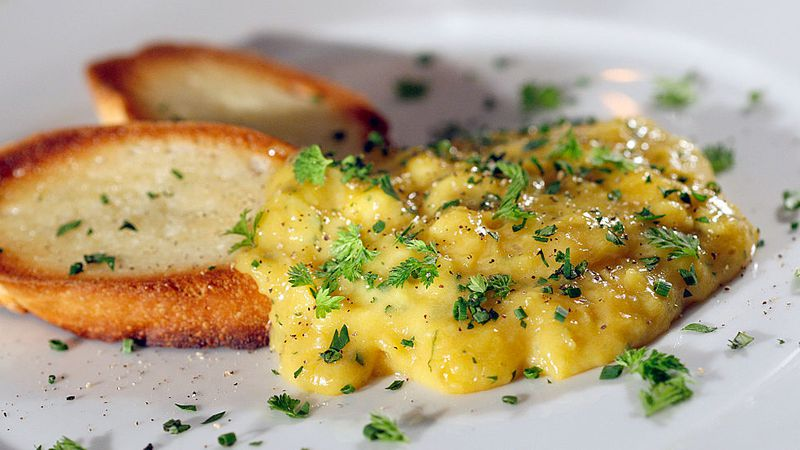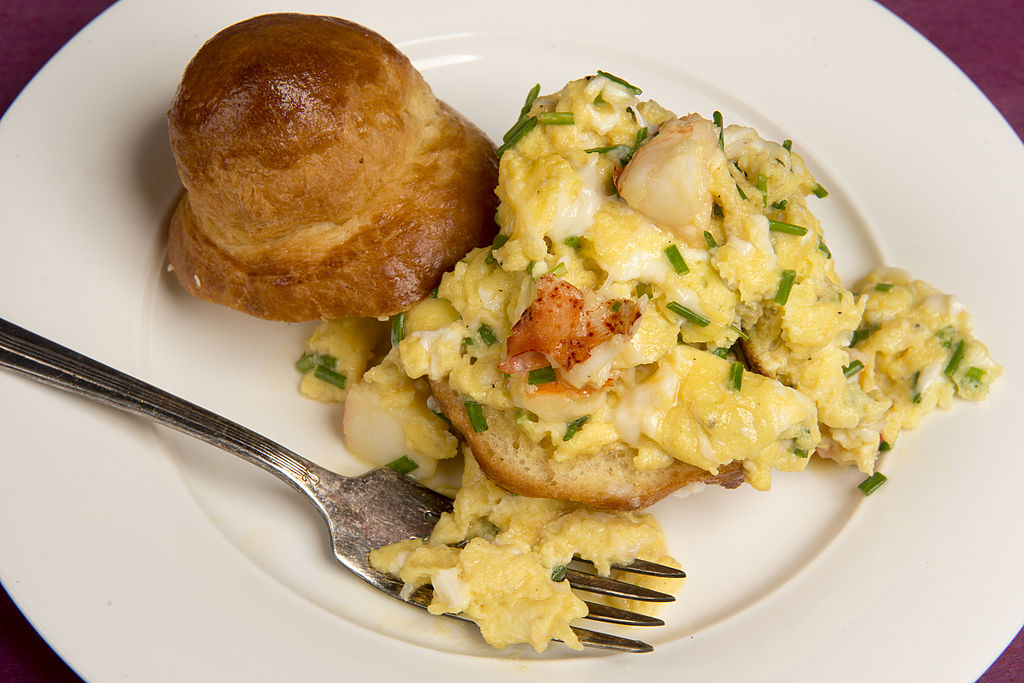Pro-Tips For Flawless Scrambled Eggs, The Hardest Dish You Could Master
We may receive a commission on purchases made from links.
Scrambled eggs fall into the genre of food that's easy to cook but difficult to master. Culinary school students could attest to instructors wielding pass/fail grades on the outcome of an egg-cooking assignment.
If only it were as simple as crack, scramble, cook, and serve. Executing flawless scrambled eggs requires acute temperature and time control, deft hands, intuition, and patience. We asked some of our favorite chefs, culinary educators, and food writers, as well as The A.V. Club staff, for their tips on nailing this hard-to-nail dish.
J. Kenji Lopez-Alt, James Beard Award-winning author of The Food Lab
Salt your eggs before scrambling them, preferably at least 15 minutes before. Despite the popular wisdom that salt will turn eggs tough, the opposite is actually the case. Salt breaks down some egg proteins which in turn means that they stay more tender and hang on to more moisture as they cook.
Paul Kahan, chef/owner of One Off Hospitality Group in Chicago
I like to whisk in a bit of creme fraiche when I'm making scrambled eggs, seasoned with salt and pepper (at times I use water if I don't have creme fraiche). Then, it's a little knob of butter—really good butter makes a big difference—and I pour the eggs when the butter is bubbly, and start moving the eggs around the whole time gently. I think people tend to cook eggs in too hot of a pan. For me, it's medium heat ideally in a non-stick or black steel pan. In a stainless steel pan, I've found that if you use oil, eggs will stick to the pan, but it doesn't stick if you use butter.
Shelley Young, owner/chef of The Chopping Block in Chicago
Any chef can tell you cooking eggs is harder than anything. Eggs go from properly cooked to overcooked in literally one second. You have a window that's so small. I worry less about undercooking the eggs and more about overcooking. With scrambled eggs, I start with a relatively high heat, then I add fat to the pan, pour in the egg, give it one good stir, and take it off the burner. I let it cook with residual heat. Somebody once told me it's not about cooking eggs; you're just warming them through.
Kevin Pang, The Takeout editor-in-chief
Three tips: Echoing Shelley Young above, I throw whisked eggs into a relatively hot pan, turn off the burner after 30 seconds, and finish the cooking using residual heat. Also, use a silicone spatula—it'll help scrape edges without scratching your pan. Finally, it's a nostalgic taste from my youth, but I always add a few dashes of Maggi seasoning sauce to my eggs. It's like a more savory, meaty soy sauce. I can't get enough.
Katie Rife, The A.V. Club news editor
Beat some sour cream in with the eggs before you cook them. It makes them creamier (obviously) and fluffier, somehow. I was told this tip came from The Sopranos, but it turned out to just be from my friend's dad. It was the mid-'00s—it was easy to mix up reality and The Sopranos back then.
Sean O’Neal, The A.V. Club senior editor
There's a scene in Michael Chabon's The Amazing Adventures Of Kavalier & Clay that's stuck with me, where Sammy reveals his "secret" to scrambled eggs is to just leave them alone over a low flame, rather than stirring them constantly like "most people." It's stuck with me because I still don't know what Chabon is talking about. Like Sammy, scrambled eggs is pretty much my only dish; I make it three to four times a week for my girls. And I can tell you that, as much as I'd like to just leave them alone for a minute or two while I attend to demands to kiss various stuffed animals, the only time I've done that, the eggs turned out flat, dry, and spat out on the floor. Instead I stir them lightly with a rubber spatula, in a counterclockwise circle, over a low flame for about two minutes, and they always turn out fluffy and delicious. Sorry, Michael Chabon. You may have won a Pulitzer, but it sure as fuck wasn't for scrambled eggs.
Marah Eakin, The A.V. Club senior editor
I'm committed to dirtying as few dishes as possible during my kitchen endeavors, so I've adopted a easy, less milky scrambled eggs method: I crack the eggs right into the pan, with some butter, and then scramble them up just like that. It's like a blend of a fried egg and scrambled eggs, and while they're not as fluffy as Katie's sour cream option, they get the job done, and they feel semi-healthy. Plus, it just makes a pan dirty, and that means less dishwashing for me. (Or my husband, as it were.)
Alex McCown-Levy, The A.V. Club assistant editor
Years ago, I was idly watching some random multi-cam sitcom—I don't know which, though I've spent hours trying to figure it out online in the years since, to no avail—but there was a teenage character who was making eggs, and a random thing he said stuck in my brain: "The secret is the paprika." So I began adding it to my scrambled eggs. The semi-sweet peppery flavor gave the dish a nice mild kick, so I began experimenting with other varieties of paprika. A good smoked paprika has become my go-to favorite, turning boring ordinary scrambled eggs into something a little more delicious (though just a little—we're not trying to overpower the eggs). Thanks, anonymous TV sitcom character, for making my scrambled eggs better.
Caity PenzeyMoog, The A.V. Club assistant editor
This prompt made me realize I have no special methods or tricks to scrambling eggs other than adding copious amounts of my family's lemon-pepper seasoning. So I asked my dad, a chef. After confirming that, indeed, instructors at the Culinary Institute Of America taught students how to cook eggs "with a gun to their heads," he recommended adding a small amount of liquid to the eggs when you beat them. Use roughly 2 tablespoons or so of water, milk, cream—it doesn't really matter—which promotes getting the eggs nicely homogenized and into a smooth mixture. He also says the eggs mix better if they've been allowed to come up to room temperature for five or 10 minutes. You want a non-stick pan, where you can add butter if you want, but it's really more about flavoring the eggs than keeping them from sticking, since you're already using a non-stick pan. Cook over a medium heat and use a rubber spatula. Move your spatula over the bottom of the pan. Push the egg that cooks at the bottom of the pan up and away, casually repeating that motion. Stop earlier if you like the creamier style egg. If you like the hard set keep cooking till you get it done. Don't at any point let eggs start to brown. Those Culinary Institute Of America instructors will kill you.
Alex Talbot and Aki Kamozawa, authors of Ideas in Food
Warning: advanced technique! By far the quickest and easiest egg dish to put on the table is scrambled eggs, which are warm, comforting and softly luxurious. Scrambled eggs can resemble soft curds or a dry sponge depending on how they are treated. They are a good example of why cooking with gentle heat can be a good thing. Higher heat leads to a higher coagulation temperature, but it also increases the rate at which the eggs scramble. By lowering the heat, we slow down the cooking process, thereby upping the possibilities of perfectly cooked results. Here we've taken the process one step further by using a hot water bath to cook the eggs. By controlling the temperature of the cooking medium, we can guarantee that the eggs will not overcook. While the eggs are cooking, your hands are free to prepare the rest of breakfast so that everything is ready at the same time.
6 large eggs1/4 cup plus 2 teaspoons (75 grams) whole milk3/4 teaspoon (4.5 grams) fine sea salt3 1/2 tablespoons (50 grams) unsalted butter
Heat a circulating water bath or a pot of water set over medium heat to 162.5 degrees Fahrenheit (72.5 degrees Celsius). Whisk the eggs together with the milk and salt. Cut the butter into small chunks and stir into the eggs. Pour the egg mixture into a vacuum or zip-top bag and seal. Place the sealed eggs in the water bath and cook for 25 minutes. Remove the bag from the bath and shake the contents. This will bring the butter into the eggs and create the small scrambled curds familiar in scrambled eggs. Serve immediately.
For a more decadent preparation, pour the contents of the bag into a whipped cream canister and aerate with one nitrous charge. Shake the contents thoroughly and then extrude the eggs.

